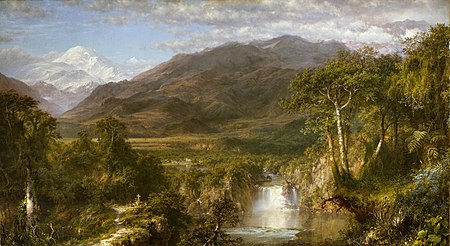
Back قلب جبال الانديز ARZ Idja ke Andes rodega (trutca ke Church) AVK El Cor dels Andes Catalan The Heart of the Andes German El corazón de los Andes (Frederic Edwin Church) Spanish دل کوههای آند Persian The Heart of the Andes French Անդերի սիրտը Armenian Jantung Andes ID The Heart of the Andes Portuguese
| The Heart of the Andes | |
|---|---|
 | |
| Artist | Frederic Edwin Church |
| Year | 1859 |
| Medium | Oil on canvas |
| Dimensions | 168 cm × 303 cm (66 in × 119 in) |
| Location | Metropolitan Museum of Art, New York |
The Heart of the Andes is a large oil-on-canvas landscape painting by the American artist Frederic Edwin Church (1826–1900). It depicts an idealized landscape in the South American Andes, where Church traveled on two occasions. Measuring more than five feet (1.5 meters) high and almost ten feet (3 meters) wide, its New York City exhibition in 1859 was a sensation, establishing Church as the foremost landscape painter in the United States.[1]
The painting was later exhibited by itself in other eastern U.S. cities. The exhibition rooms featured special lighting and decorative elements reminiscent of the depicted landscape, and the painting was supported by a floor-standing frame. The public was often enchanted by the amount of detail portrayed in it, willing to wait in line and pay a 25-cent entrance fee. Church synthesized numerous topographies of the Andes into his composition, from Mount Chimborazo to a plain and a jungle. In the details, there are numerous animals and indications of human settlement, including people visiting a cross in the left foreground.
The Heart of the Andes has been in the collection of New York's Metropolitan Museum of Art since 1909. Its first sale, to William Tilden Blodgett, broke a price record for a living American artist. It is among Church's most renowned works and an important 19th-century American painting.
- ^ Craven, Wayne (2002). American Art: History and Culture. McGraw-Hill Professional. pp. 207–209. ISBN 978-0-07-141524-8.